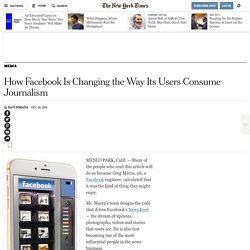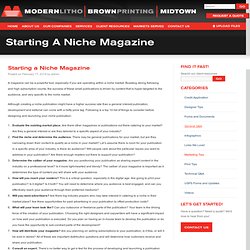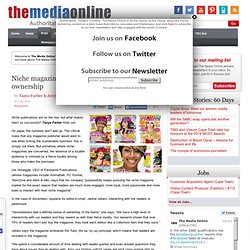

How Facebook Is Changing the Way Its Users Consume Journalism. In an interview at Facebook’s sprawling headquarters here, which has a giant, self-driving golf cart that takes workers between buildings, Mr.

Marra said he did not think too much about his impact on journalism. “We try to explicitly view ourselves as not editors,” he said. “We don’t want to have editorial judgment over the content that’s in your feed. You’ve made your friends, you’ve connected to the pages that you want to connect to and you’re the best decider for the things that you care about.” In Facebook’s work on its users’ news feeds, Mr. Roughly once a week, he and his team of about 16 adjust the complex computer code that decides what to show a user when he or she first logs on to Facebook. The goal is to identify what users most enjoy, and its results vary around the world. If Facebook’s algorithm smiles on a publisher, the rewards, in terms of traffic, can be enormous. Mr. Ms. The Post is putting time and energy into such efforts, Ms. Mr. Blendle: will the 'iTunes of journalism' strike a chord worldwide? A Dutch startup that describes itself as “iTunes for newspapers” has received €3m (£2.4m) backing from the New York Times Co and German publisher Axel Springer, and plans to launch in a major European country within six months.

Blendle, which launched just six months ago, has changed the way newspaper articles in the Netherlands are consumed by readers: it acts as a digital kiosk, selling individual articles at a cost of 20 cents, from a variety of newspapers and magazines. It will be interesting to see how the Blendle model can work abroad at a time of dwindling print sales. Founders Alexander Klöpping and Marten Blankesteijn, 27-year-old former journalists, wanted paying for a newspaper article to be as easy as downloading an app. “We have been building something the way we wanted to consume news,” Klöpping, who is also a tech journalist appearing on the largest talkshow in the Netherlands and who has made a documentary about Silicon Valley, tells the Guardian. Starting a Niche Magazine - Modern Litho. A magazine can be a powerful tool, especially if you are operating within a niche market.

Boasting strong following and high subscription counts, the success of these small publications is driven by content that is hyper-targeted to the audience, and very specific to the niche market. Although creating a niche publication might have a higher success rate than a general interest publication, development and editorial can come with a hefty price tag. Following is a top 10 list of things to consider before designing and launching your niche publication: Evaluate the existing market place.
Are there other magazines or publications out there catering to your market? After you get your publication off the ground, don’t forget to perform these critical steps to keep it going strong: Ask for and take feedback seriously. The squishy middle: The risk to consumer magazines of not being massive or niche. "Restricted distribution has essentially been shaping the market, The strong niches will survive, and the brand leaders, (but) the middle ground is in for a great clear out and we’re going through that.

" That's from Tim Davie, the new CEO of BBC Worldwide, talking last week. He's preoccupied by broadcast media - but he could be talking about any sector. Newspapers and magazines grew to deliver more advertising - but this led to a large number of titles within specific content areas: think of women's and men's titles in the 1990s, many of which are no longer around. Is there a squishy middle to this industry that's neither niche enough of big enough to survive? We love magazines. Stack: A lifeline for those niche indie magazines.
Here's a great take on the online magazine subscription site.

It used to be the sign of a clueless publisher - a website with nothing but a credit card form to make you pay for the print subscription. There are still more than a handful of those around... Stack has turned that on its head, and is doing great things for the independent magazine sector. 13 Expensive Niche Magazines That Are Still Surviving In Print. Issue 9 — Offscreen Magazine. Interviewees Cameron Moll Designer/Founder of Authentic Jobs — on his failed attempt at a music career, the online business that grew out of a sidebar, and his love for letterpressed typography.

Ruchi Sanghvi Developer/Investor — on growing up in India, experimental engineering for hundreds of millions of users, and her changing definition of success. Drew Downs. Magazine Publishing - Lanse Claude. Niche magazines: giving readers a sense of ownership. Niche publications are on the rise, but what makes them so successful?

Tanya Farber finds out. On paper, the numbers don’t add up. The critical mass that any magazine publisher would want to see when ticking the ‘sustainable business’ box is simply not there. But somehow, where niche magazines are concerned, the absence of a sizable audience is mirrored by a fierce loyalty among those who make the purchase.
Urs Honegger, CEO of Panorama Publications (whose magazines include Animaltalk, PC Format, TeenZone and Mom & Me), says that his company “purposefully keeps pursuing the niche magazine market for the exact reason that readers are much more engaged, more loyal, more passionate and more keen to interact with their niche magazine”. In the case of Seventeen, explains its editor-in-chief, Janine Jellars, interacting with the readers is paramount. “Seventeeners feel a definite sense of ownership of the brand,” she says. So what are the challenges?